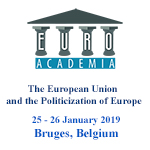Euroacademia Conferences
 Europe Inside-Out: Europe and Europeanness Exposed to Plural Observers (9th Edition) April 24 - 25, 2020
Europe Inside-Out: Europe and Europeanness Exposed to Plural Observers (9th Edition) April 24 - 25, 2020 Identities and Identifications: Politicized Uses of Collective Identities (9th Edition) June 12 - 13, 2020
Identities and Identifications: Politicized Uses of Collective Identities (9th Edition) June 12 - 13, 2020 8th Forum of Critical Studies: Asking Big Questions Again January 24 - 25, 2020
8th Forum of Critical Studies: Asking Big Questions Again January 24 - 25, 2020 Re-Inventing Eastern Europe (7th Edition) December 13 - 14, 2019
Re-Inventing Eastern Europe (7th Edition) December 13 - 14, 2019 The European Union and the Politicization of Europe (8th Edition) October 25 - 26, 2019
The European Union and the Politicization of Europe (8th Edition) October 25 - 26, 2019 Identities and Identifications: Politicized Uses of Collective Identities (8th Edition) June 28 - 29, 2019
Identities and Identifications: Politicized Uses of Collective Identities (8th Edition) June 28 - 29, 2019 The European Union and the Politicization of Europe (7th Edition) January 25 - 26, 2019
The European Union and the Politicization of Europe (7th Edition) January 25 - 26, 2019 7th Forum of Critical Studies: Asking Big Questions Again November 23 - 24, 2018
7th Forum of Critical Studies: Asking Big Questions Again November 23 - 24, 2018 Europe Inside-Out: Europe and Europeanness Exposed to Plural Observers (8th Edition) September 28 - 30, 2018
Europe Inside-Out: Europe and Europeanness Exposed to Plural Observers (8th Edition) September 28 - 30, 2018 Identities and Identifications: Politicized Uses of Collective Identities (7th Edition) June 14 - 15, 2018
Identities and Identifications: Politicized Uses of Collective Identities (7th Edition) June 14 - 15, 2018
Contemporary Art Exhibitions as a Tool for the Democratisation of Europe Between 1989 and 2004
-
-

-
Presentation speakers
- Mateusz Sapija, Edinburgh College of Art, University of Edinburgh, UK
Abstract:
The proposed paper will examine the role of contemporary art exhibitions in the process of the political integration of Europe between the end of the Cold War (1989) and the Eastern Enlargement (2004). To do so, the paper will discuss a range of inter-European exhibitions which aimed to construct and disseminate a new notion of a “united” European contemporary art world. Those exhibition projects – organised predominantly by Northern and Western European art institutions – intended to either ‘bring together’ artists from the former East and West so as to break the dichotomies of their distinct socio political roots; or to conduct major surveys of Eastern European art within the framework of the newly globalised art world in order to legitimize art from the region and place it in the universal (Western) cultural context. The paper will discuss resonating examples of these institutional (and simultaneously political) strategies informing exhibitions such as ‘Interpol’ (1996), ‘Europa, Europa’ (1994), ‘Manifesta 1′ (1996) and ‘Manifesta 2′ (1998) as well as attend to and examine less debated exhibitions including ‘Kunst, Europa: 63 deutsche Kunstvereine zeigen Kunst aus 20 Ländern’ (1991) and ‘After the Wall: Art and Culture in Post-communist Europe’ (1999). This presentation will seek to problematise the use of contemporary art as a presumably neutral platform of dialogue between Eastern and Western European states, which supported the process of socio-political Europeanisation of the former East. At the same time, it will situate the aforementioned projects within the broader debates on the attempts to construct the post-ideological socio-political landscape of democratised Europe post-1989 through the means of contemporary art.
-
Related Presentations

Justice for Europe
- Valentina Surace

Brexit, History and Education: Recognising Conflict in a Period of Upheaval
- Erin Bell
- Florian Gleisner













